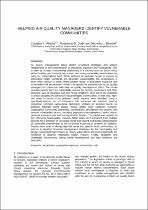JavaScript is disabled for your browser. Some features of this site may not work without it.
- ResearchSpace
- →
- Research Publications/Outputs
- →
- Conference Publications
- →
- View Item
| dc.contributor.author |
Wright, C

|
|
| dc.contributor.author |
Diab, RD

|
|
| dc.contributor.author |
Binedell, ML

|
|
| dc.date.accessioned | 2009-12-03T14:08:27Z | |
| dc.date.available | 2009-12-03T14:08:27Z | |
| dc.date.issued | 2008-10 | |
| dc.identifier.citation | Wright, C, Diab, RD and Binedell, ML. 2008. Helping air quality managers identify vulnerable communities. National Association for Clean Air Conference (NACA 2008). Nelspruit, South Africa, 1-3 October 2008, pp 6 | en |
| dc.identifier.uri | http://hdl.handle.net/10204/3798 | |
| dc.description | National Association for Clean Air Conference (NACA 2008). Nelspruit, South Africa, 1-3 October 2008. | en |
| dc.description.abstract | Air quality management plans identify prioritised strategies and actions independent of any consideration of population exposure and vulnerability. This is seen as a major shortcoming, particularly in a country such as South Africa where funding and capacity are scarce, and many vulnerable communities are living on marginalised land. While ambient air pollution levels in excess of prescribed health standards are generally unacceptable, the exceedance is even more serious in areas where people reside. A population exposure and vulnerability risk prioritisation model is proposed for potential use by air quality managers in conjunction with their air quality management plans. The model includes factors such as vulnerability caused by poverty, respiratory and other diseases, lack of education and poor living conditions, all of which are important in areas occupied by previously disadvantaged communities. In this way, highrisk areas in terms of air pollution health impacts were identified using a specifically-tailored set of indicators that assessed air pollution sources (industrial, vehicular, agricultural, domestic); ambient air pollution levels; air pollution potential (wind speed, mixing depth, solar radiation, humidity, topography); community awareness, observations, perceptions and actions; and several vulnerability factors, including population demographics, health status, personal exposure risk and socioeconomic factors. The model was applied to the eThekwini Municipality, KwaZulu-Natal. Data were extracted from multiple sources for a selection of municipal wards and scored to illustrate categorisation of vulnerable communities at risk of excess exposure to ambient air pollution. Results were used to identify high risk areas and specific local communities, as well as to develop focussed management strategies for the municipality and design customised interventions to reduce vulnerability and more importantly the incidence of adverse respiratory health impacts. Finally, obstacles and challenges encountered during model development and data collection are described | en |
| dc.language.iso | en | en |
| dc.publisher | National Association for Clean Air Conference (NACA 2008). | en |
| dc.subject | Air pollution | en |
| dc.subject | Air quality management | en |
| dc.subject | Population exposure | en |
| dc.subject | Vulnerable communities | en |
| dc.title | Helping air quality managers identify vulnerable communities | en |
| dc.type | Conference Presentation | en |
| dc.identifier.apacitation | Wright, C., Diab, R., & Binedell, M. (2008). Helping air quality managers identify vulnerable communities. National Association for Clean Air Conference (NACA 2008).. http://hdl.handle.net/10204/3798 | en_ZA |
| dc.identifier.chicagocitation | Wright, C, RD Diab, and ML Binedell. "Helping air quality managers identify vulnerable communities." (2008): http://hdl.handle.net/10204/3798 | en_ZA |
| dc.identifier.vancouvercitation | Wright C, Diab R, Binedell M, Helping air quality managers identify vulnerable communities; National Association for Clean Air Conference (NACA 2008).; 2008. http://hdl.handle.net/10204/3798 . | en_ZA |
| dc.identifier.ris | TY - Conference Presentation AU - Wright, C AU - Diab, RD AU - Binedell, ML AB - Air quality management plans identify prioritised strategies and actions independent of any consideration of population exposure and vulnerability. This is seen as a major shortcoming, particularly in a country such as South Africa where funding and capacity are scarce, and many vulnerable communities are living on marginalised land. While ambient air pollution levels in excess of prescribed health standards are generally unacceptable, the exceedance is even more serious in areas where people reside. A population exposure and vulnerability risk prioritisation model is proposed for potential use by air quality managers in conjunction with their air quality management plans. The model includes factors such as vulnerability caused by poverty, respiratory and other diseases, lack of education and poor living conditions, all of which are important in areas occupied by previously disadvantaged communities. In this way, highrisk areas in terms of air pollution health impacts were identified using a specifically-tailored set of indicators that assessed air pollution sources (industrial, vehicular, agricultural, domestic); ambient air pollution levels; air pollution potential (wind speed, mixing depth, solar radiation, humidity, topography); community awareness, observations, perceptions and actions; and several vulnerability factors, including population demographics, health status, personal exposure risk and socioeconomic factors. The model was applied to the eThekwini Municipality, KwaZulu-Natal. Data were extracted from multiple sources for a selection of municipal wards and scored to illustrate categorisation of vulnerable communities at risk of excess exposure to ambient air pollution. Results were used to identify high risk areas and specific local communities, as well as to develop focussed management strategies for the municipality and design customised interventions to reduce vulnerability and more importantly the incidence of adverse respiratory health impacts. Finally, obstacles and challenges encountered during model development and data collection are described DA - 2008-10 DB - ResearchSpace DP - CSIR KW - Air pollution KW - Air quality management KW - Population exposure KW - Vulnerable communities LK - https://researchspace.csir.co.za PY - 2008 T1 - Helping air quality managers identify vulnerable communities TI - Helping air quality managers identify vulnerable communities UR - http://hdl.handle.net/10204/3798 ER - | en_ZA |






